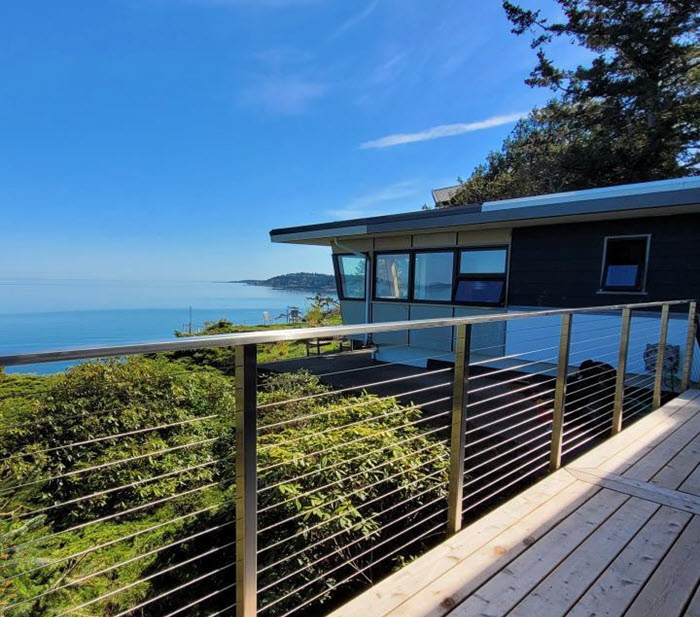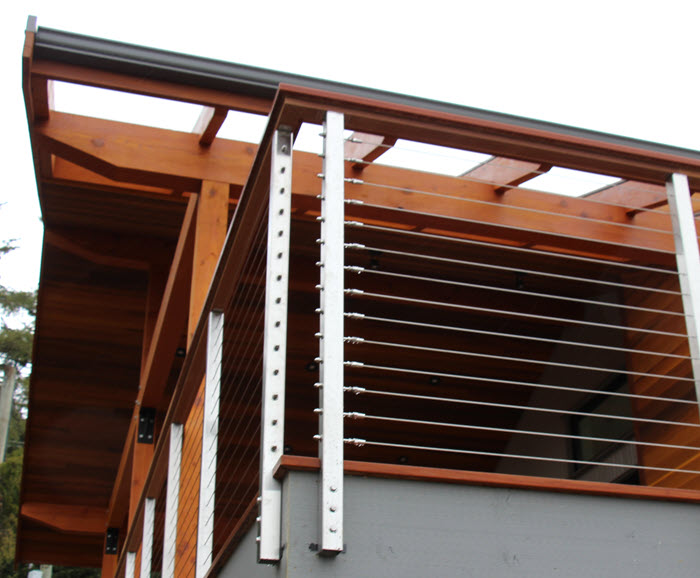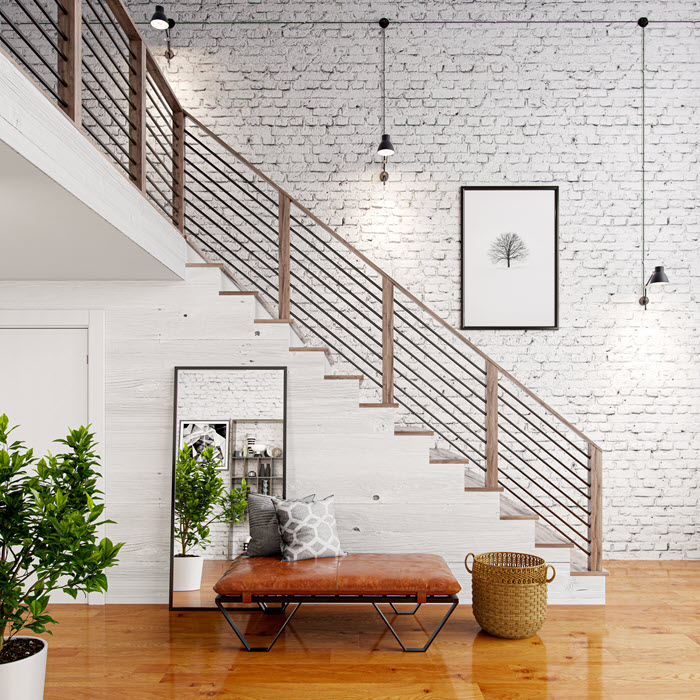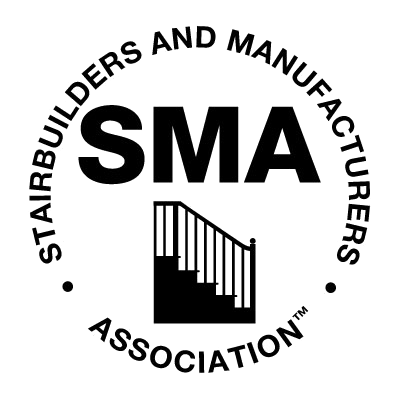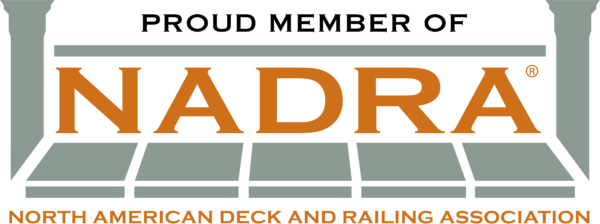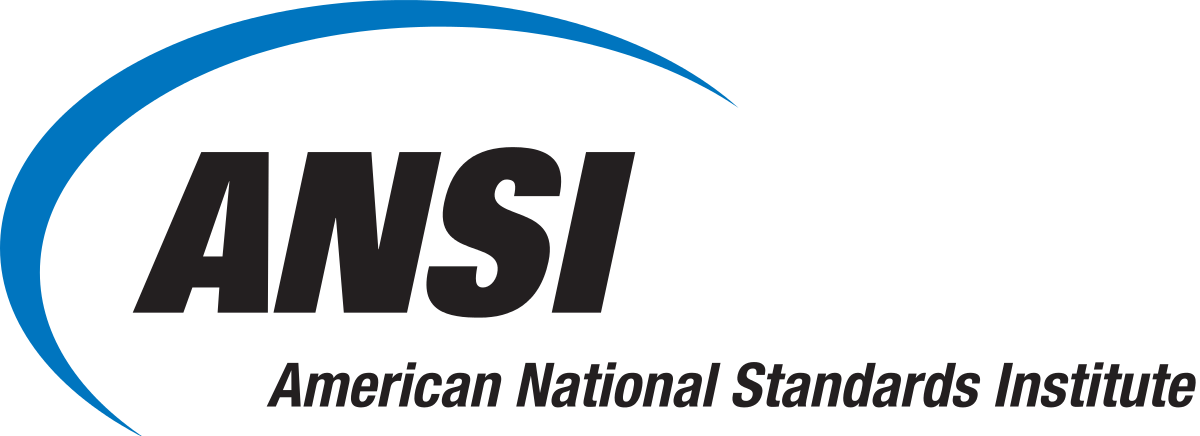- Jan 03, 2022
Cable Railing 101: The Basics, Installation Resources and Expert Tips
-
Share:
Photo Source: Bezdan Railing Solutions. Cable railing gives this coastal home a modern update and brings light and airiness to the deck.
Why Choose Cable Railing?
Cable railing systems are a stylish way to update and modernize interior and exterior stairs and decks. One of the great features of a cable railing is how easily it can open up space, big or small, by removing visual barriers. This versatile railing option complements a range of décors, from modern and contemporary, to traditional and classic.
This article takes you through the fundamentals of cable railing infill requirements, style and function options, and planning and installation tips.
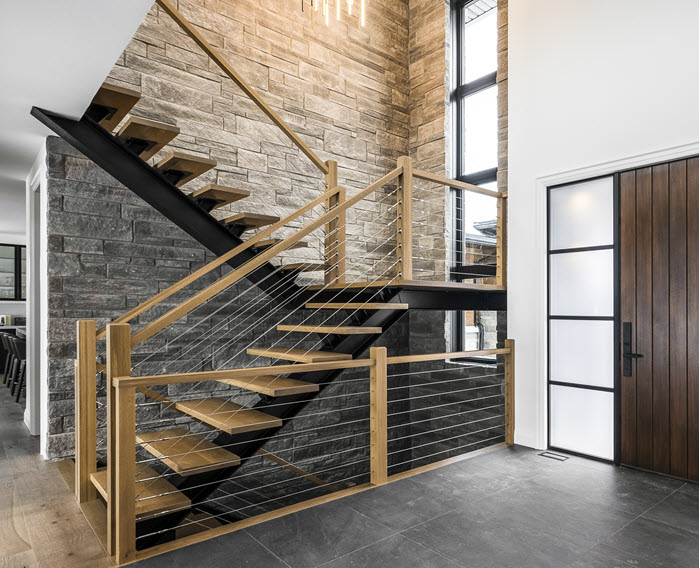
Photo Source: Bezdan Railing Solutions.Stainless steel surface mount fittings and wood posts bring a mix of material and visual interest to this entryway of this mountain home.
Choosing Your Railing Options
The cable railing system you choose will be dependent on personal preferences and project parameters. Whether you're planning a new build or renovation to an existing deck or staircase, there are many options available for professionals and DIYers.
Selecting Your Mounting Substrate
The choice of the post is one of the most important and will significantly impact the guard's finished look. Stainless steel and wood are the most popular materials chosen for posts. Stainless steel is popular as it provides a contemporary look that fits with various home decors, from an industrial-style loft to trending modern farmhouse interiors.
Wood is widely used to combine its natural warmth and beauty with the contemporary appeal of stainless steel cable. In some cases, a post is not required or not possible due to limited space, so cable infill must secure directly to a concrete substrate, like a foundation wall, when installing on a deck. The good news is there are cable fittings available to work with metal, wood, or concrete frameworks.
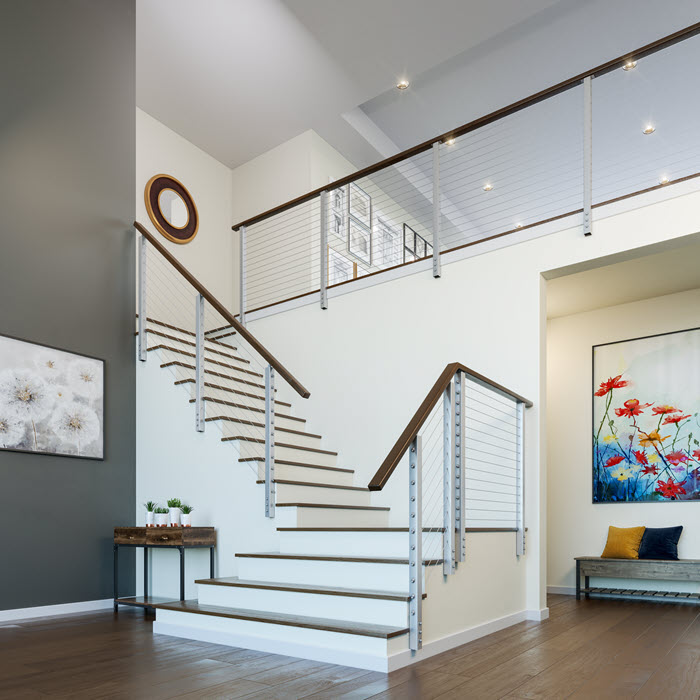
Photo Source: Bezdan Railing Solutions. Sleek stainless steel posts and wood handrail fit perfectly on the stairway and landing of this modern farmhouse style home.
Cable End Fittings – Choosing Style & Function
Once you've determined the mounting substrate for the railing framework, it's time to select the fittings. Cable railing infill is formed using multiple runs of cable secured to the post or other substrate with end fittings. Cable fittings are distinguished by mounting type and function. The choices of mounting type are either surface mount or through-post, and the function is either tensioning or non-tensioning. Once you determine what you need, it’s time to determine what style of cable fittings will create the look you are after.
Mounting type. End fittings are available with surface-mount or through-post options. If you aren’t limited by the construction requirements of your guard rail, you can choose from a variety of fittings to suit your design preferences.

Through-post fittings, with little to no visible hardware, help maximize the view. Access to the back of the end post is required to secure these fittings. You’ll typically need at least 3-1/2” of space behind the post to allow access for installation.

Surface mount fittings mean the hardware is exposed, achieving a railing design style for either a contemporary staircase or nautical-chic deck. Fittings secure to the inside of the post or substrate, which is ideal if the back of the post is not accessible.
Fitting function. Now that you’ve chosen your mounting type and design you like, select fittings by function. Each run of cable requires a tensioning and non-tensioning fitting. The tensioner is used to remove slack in the cable run while the non-tensioner holds the cable in place while cables are being tensioned. In some cases, like extra-long runs, a tensioning fitting is required on both ends.
★ Expert tip: All runs of cable and end fittings are installed before tensioning. Follow the recommended tensioning sequence to ensure proper installation and achieve optimal results. Typically, tensioning starts from the middle run and then alternates outward with the bottom row as the final run to tension. See diagram in this guide.
Photo Source: Bezdan Railing Solutions. Cable railing using through-post fittings opens up the space in this narrow walkway and keeps sightlines clear.
Where To Start When Planning A Cable Railing Installation?
Once you've reviewed the cable railing hardware options, there are some basic requirements you need to know when planning and installing cable railing. Here are some key points to keep in mind.
- A top rail is always necessary for structural integrity when building a guard rail with cable infill
- A complete railing will include 11 – 14 rows of cable depending on post height, framework construction, and cable spacing
- A three-inch spacing between rows is recommended as it considers cable deflection to comply with code requirements
- The cable should be supported by a post, mid-post, or cable brace no less than every 48 inches to keep consistent cable spacing and prevent sagging
- The railing framework must be stable and robust enough to support a minimum of 225 lbs. tension per cable
How To Handle Corners
A common question we are asked is how to handle corners for a cable railing installation. Since the properties of cable do not accommodate bends past 45 degrees, to create a 90-degree corner and to allow for proper tensioning, choose from these solutions:
Double post configuration: See examples below for how you can use a double post configuration to handle corners.
In a double post corner configuration, the cable run can terminate at the end post and start up again at the next post to create the corner.
Photo Source: Bezdan Railing Solutions. View of a double post configuration using Bezdan Cable through-post fittings where each cable run terminates at the end post.
Another solution is to place posts to allow for the cable to pass through at a maximum of 45 degrees.
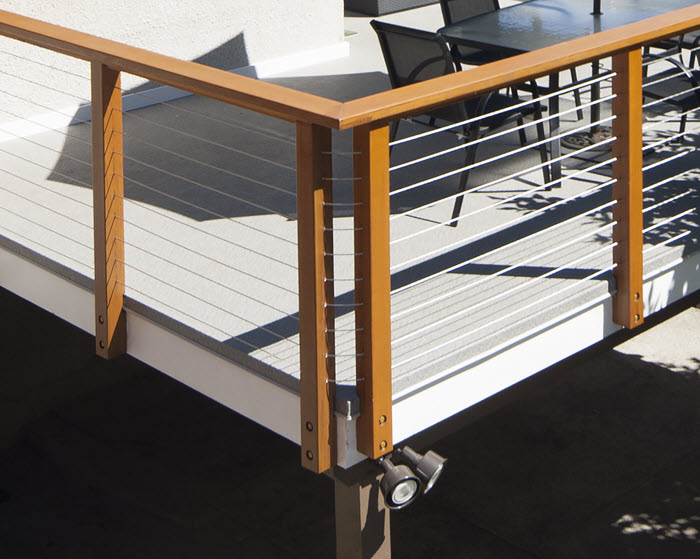
Photo Source: Bezdan Railing Solutions. View of a double post configuration allowing for a 45-degree pass-through.
★ Expert tip: On wood posts, use a cable post protector sleeve for corner and angled applications to keep the cable from biting into the wood.
Single post configuration: See examples below for how you can use a single post configuration to handle corners.
A common single post configuration uses surface mount fittings to create the corner.

Photo Source: Bezdan Railing Solutions. A single corner post configuration using Bezdan Cable surface mount fittings.
Another option to achieve a 90˚ corner is to use a through-post and a surface mount fitting. If only through-post fittings are used, the runs will need to be offset at the post junction and may appear unbalanced.

Illustration showing a single corner post configuration using RailFX® through-post and surface mount fittings.
Products That Save Time
Whether you’re new to cable railing or a seasoned installer, everyone can benefit from products that save time on installations with reduced labor hours and without expensive investments in equipment.

Bezdan Cable pre-drilled fascia mount cable posts make installations much faster and more efficient. No need to drill and tap.
Pre-drilled fascia mount cable posts provide an off-the-shelf time and cost-saving solution with no need to drill and tap holes.
- Alloy 316L for maximum corrosion resistance
- Designed to work with Bezdan Cable through-post fittings and top mount brackets
- Intermediate and end posts for level and stair applications
- Engineered for safety
- Products meet ASTM A554 standard
Photo Source: Bezdan Sales. Quick-to-install, swageless fittings can be secured safely by hand with simple tools.
Bezdan’s cable fittings are the ideal choice! Fittings are swageless; this means the hardware to affix the cable to the post installs with simple hand tools.
- Alloy 316L for maximum corrosion resistance
- CNC machined for precision craftsmanship
- Electro-polished for superior quality & finish
- 10-Year Limited Warranty
- Test report available
- Products meet AISI steel grade designation
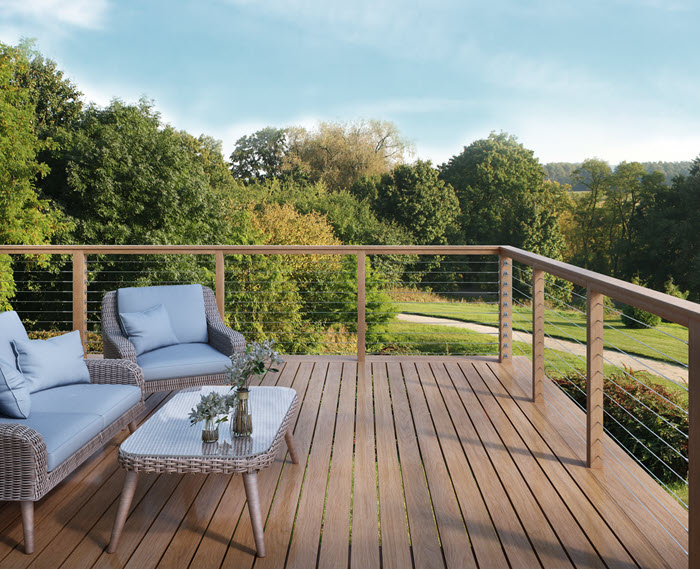
Photo Source: Bezdan Railing Solutions. Cable railing opens up the views from this backyard deck.
★ Expert tip: Install cable infill in a controlled setting, if possible, to prevent loss and cross-contamination from dissimilar metals. Cable fittings include many small parts. If your project is located outdoors, plan how you can reduce the possibility of losing hardware on a windy deck. If you’re a fabricator, consider installing end fittings to posts in the shop and ensure that the shop environment is contaminant-free. See more tips on stainless steel care and maintenance here.

Photo Source: Bezdan Railing Solutions. Horizontal cable railing complements the light and airy feel of this open-riser staircase.
Installation Resources
Bezdan has numerous resources to help you complete a safe, secure and successful cable railing installation. Here are some handy links to guide you through the process.
- Framework Requirements, Fitting Selection and Tool Guide
- Installation Guide: Bezdan Cable Fascia Mount Post Stair & Level
- Installation Videos

Photo Source: Bezdan Railing Solutions. Stainless steel posts with cable creates a modern industrial look for this commercial office space.
Request A Quote
Now that you’ve covered the basics, it’s time to take the next step. With over a decade of experience in cable railing, our knowledgeable Customer Service team is here to help with product recommendations and quoting for your specific project needs. Request a Quote.
Related Articles
- 8 Questions to Ask Before Installing Cable Railing
- Why Cable Railing is Hot Right Now
- Before and After: Witness the Stunning Transformation of An Outdoor Space Thanks to Cable Railing
- 9 Gorgeous Spaces with Indoor Cable Railings



